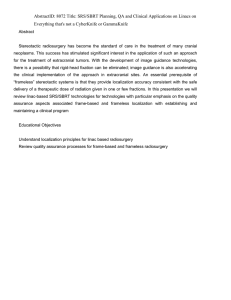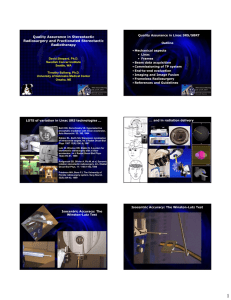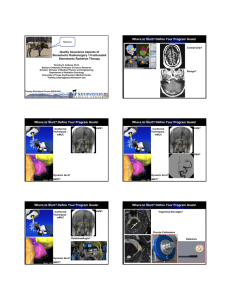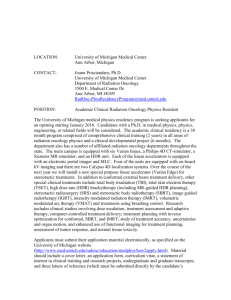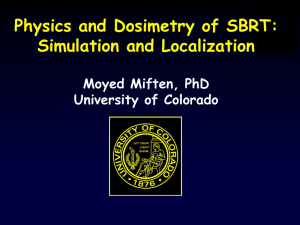Implementing New Technologies for Stereotactic Radiosurgery and Stereotactic
advertisement
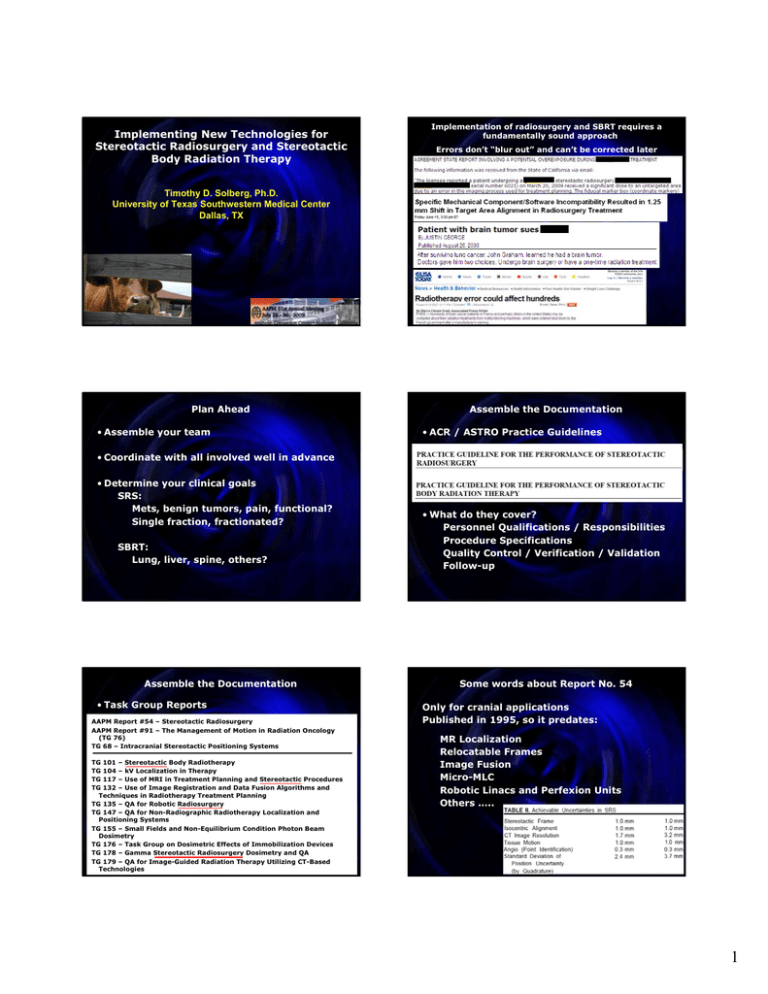
Implementing New Technologies for Stereotactic Radiosurgery and Stereotactic Body Radiation Therapy Implementation of radiosurgery and SBRT requires a fundamentally sound approach Errors don’t “blur out” and can’t be corrected later Timothy D. Solberg, Ph.D. University of Texas Southwestern Medical Center Dallas, TX Plan Ahead • Assemble your team Assemble the Documentation • ACR / ASTRO Practice Guidelines • Coordinate with all involved well in advance • Determine your clinical goals SRS: Mets, benign tumors, pain, functional? Single fraction, fractionated? SBRT: Lung, liver, spine, others? Assemble the Documentation • Task Group Reports AAPM Report #54 – Stereotactic Radiosurgery AAPM Report #91 – The Management of Motion in Radiation Oncology (TG 76) TG 68 – Intracranial Stereotactic Positioning Systems TG 101 – Stereotactic Body Radiotherapy TG 104 – kV Localization in Therapy TG 117 – Use of MRI in Treatment Planning and Stereotactic Procedures TG 132 – Use of Image Registration and Data Fusion Algorithms and Techniques in Radiotherapy Treatment Planning TG 135 – QA for Robotic Radiosurgery TG 147 – QA for Non-Radiographic Radiotherapy Localization and Positioning Systems TG 155 – Small Fields and Non-Equilibrium Condition Photon Beam Dosimetry TG 176 – Task Group on Dosimetric Effects of Immobilization Devices TG 178 – Gamma Stereotactic Radiosurgery Dosimetry and QA TG 179 – QA for Image-Guided Radiation Therapy Utilizing CT-Based Technologies • What do they cover? Personnel Qualifications / Responsibilities Procedure Specifications Quality Control / Verification / Validation Follow-up Some words about Report No. 54 Only for cranial applications Published in 1995, so it predates: MR Localization Relocatable Frames Image Fusion Micro-MLC Robotic Linacs and Perfexion Units Others ….. 1 Assemble the Documentation RTOG 0236 has something for everyone • RTOG Protocols Anatomy Definition RTOG 9005 – Single Dose Radiosurgical Treatment of Recurrent Previously Irradiated Primary Brain Tumors and Brain Metastases RTOG 9305 – Randomized Prospective Comparison Of Stereotactic Radiosurgery (SRS) Followed By Conventional Radiotherapy (RT) With BCNU To RT With BCNU Alone For Selected Patients With Supratentorial Glioblastoma Multiforme (GBM) RTOG 9508 – A Phase III Trial Comparing Whole Brain Irradiation Alone Versus Whole Brain Irradiation Plus Stereotactic Radiosurgery for Patients with Two or Three Unresected Brain Metastases RTOG 0236 – A phase II trial of SBRT in the treatment of patients with medically inoperable stage I/II non-small cell lung cancer RTOG 0618 – A phase II trial of SBRT in the treatment of patients with operable stage I/II non-small cell lung cancer RTOG 0813 – Seamless phase I/II study of SBRT for early stage, centrally located, non-small cell lung cancer in medically operable patients OAR Constraints Other Documents Guidance for physicists ASTRO/AANS Consensus Statement on stereotactic radiosurgery quality improvement, 1993 RTOG Radiosurgery QA Guidelines, 1993 European Quality Assurance Program on Stereotactic Radiosurgery, 1995 DIN 6875-1 (Germany) Quality Assurance in Stereotactic Radiosurgery/Radiotherapy, 2004 … and read the literature! Determine how you will: Determine what kinds of delivery techniques will be used • IMRT? • Simulate • Dynamic Arcs? • Manage Motion 4DCT / Compress / Gate / Track …. • VMAT? • Immobilize • Robotic Delivery? • Localize MV / kV / CBCT / Calypso …. • Verify 2 Example: Novalis Tx Assemble the proper resources Real-time Stereoscopic Infrared Imaging • Personnel • Time Dual Energy Linac w/ HD-120 Electronic MLC:Portal 2.5 and SRS mode and multiple 5 mm Imaging leaves energy electrons • Equipment Dosimetry Equipment Specialized Phantoms Immobilization Devices • Clarify procedures and responsibilities, and design QA program As the physicist, you will be responsible for all of the technical details! Example: Novalis Tx SRS SRTPositioner Frame Mask Target Stereotactic Localizer On-board Imaging Room-mounted and CBCT Stereoscopic Imaging New Planning System with Many Delivery Techniques Circular Winston-Lutz Collimator Couch Collimators Mount Mount Tool New Planning System with Many Delivery Techniques Gating Robotic Couch Dynamic Arcs Conformal Gating AVMs SBRTBeams CircularIMRT Collimators Trigeminal Neuralgia Prepare for the task at hand Commissioning photons on a Novalis Tx is akin to commissioning 7 beams: Cones-Direct Measurement XLow Standard-Pencil Beam XLow SRS-Pencil Beam XHigh Standard-Pencil Beam XLow Standard-Monte Carlo XLow SRS-Monte Carlo XHigh Standard-Monte Carlo 3 Get the Documentation Small fields require small detectors Circular collimators 4 – 15 mm in diameter MLC fields 5x5 mm2 – 400x400 mm2 Get the right equipment Be careful with diodes and radiographic film 1) Both diodes and film are energy dependent, and the energy spectrum varies considerably for small fields relative to large fields. So: - Use Gafchromic film, not radiographic film - Use an intermediate reference field appropriate for both diodes and ion chambers Monte Carlo requires scanned data in air Need a brass buildup cap for your small chamber Reference diode output to an intermediate field size 2) Diode response drifts over time - Re-measure reference between each change in field size The Million Dollar Question – Are your data correct? 1 Output Factor NO! YES! = Reading (FS)diode Reading (Ref’)diode X Reading (Ref’)IC Reading (Ref)IC Reading (5 mm)diode Relative Output Factor Circular Collimators - XLow 0.9 0.8 0.7 0.6 0.1 Reading (100 mm)diode Reading (5 mm)diode Reading (20 mm)diode X Reading (20 mm)IC 0 0 2 4 6 8 10 12 14 16 Field Diameter (mm) Reading (100 mm)IC 4 Compare with Existing Data Compare with Existing Data HD-120 Fields – XLow Standard Mode HD-120 Fields – XLow SRS Mode Institution 1 Institution 2 Off Axis Profiles – Cones Diagonal (Radial) Profiles – Standard Mode This shouldn’t be difficult, but ….. Output Factor ~45% Know how your data is processed and what the planning system does with it Institution 5 A different institution in the U.S And people continue to have problems Institution in the U.S Cone size (mm) Original Output Factor 1.2 Institution A 1 Re-measured Output Factor Institution B 0.8 4.0 7.5 10.0 12.5 15.0 17.5 20.0 25.0 30.0 0.312 0.610 0.741 0.823 0.862 0.888 0.903 0.920 0.928 0.699 0.797 0.835 0.871 0.890 0.904 0.913 0.930 0.940 0.6 0.4 0.2 0 0 50 100 150 200 250 300 Depth (mm) Commissioning your system: Does calculation agree with measurement? And still another institution in the U.S 110 100 90 Institution A Institution B Percent Depth Dose 80 6.0 % 70 10.3 % 60 50 40 30 20 10 0 0 50 100 150 200 250 300 350 400 450 Depth (mm) Start simple, and increase complexity End-to-end testing Dosimetric uncertainty 1 isocenter Calculation Calculation arc-step = 10o arc-step = 2o 4 field box Dynamic Conformal Arcs 2 isocenters – off axis Relative Dosimetry 2 isocenters – on axis IMRT 6 End-to-end testing Dosimetric uncertainty End-to-end dosimetric evaluation Absolute Dosimetry Lucy Phantom Lucy Phantom End-to-end dosimetric evaluation End-to-end dosimetric evaluation End-to-end dosimetric evaluation Isocentric Accuracy: The Winston-Lutz Test 7 Mechanical Uncertainties Perform for Cones and MLC Is the projection of the ball centered within the field? Good results ≤ 0.5 mm Is the projection of the ball centered within the field? End-to-end localization evaluation Structure Cylinder Cube Cone Sphere AP 0.0 20.0 -35.0 25.0 Phantom Specifications LAT VERT 0.0 30.0 -17.0 40.0 -20.0 40.0 20.0 32.7 iPlan Stereotactic Coordinates AP LAT VERT 1.0 0.4 30.8 20.8 -17.1 42.4 -34.6 -19.7 40.8 25.5 20.2 33.5 End-to-End Localization Accuracy 8 Fusion Verification Verification of MLC shapes and isocenter MR Fusion Hidden Target Test scan, plan, localize assess RPC Phantom Use ALL the RPC phantoms Lucy Phantom Immobilization / Motion Management Use abdominal compression (typically) to control tumor motion to less than 0.5-1.0 cm. We visualize the tumor OR use the dome of diaphragm Perform 4-D CT (using bellows for phase) under compression 9 How will you use 4D CT? Maximum Intensity Projection ITV PTV AVG Uncompressed Compressed How do you know its all correct? Localization – Frame Based or Image Based? Image Guided Localization – Anatomy or Markers? Frame-assisted image guidance – never frame alone Depends on the image guidance methodology and the anatomy / application Localization – Stereo X-rays Have lots of redundancy 10 How do we know the system is targeting properly? End-to-end evaluation that mimics a patient procedure Also works well in Spine X-ray Identify target & plan DRR Set up in treatment room Irradiate Evaluate Results of Phantom Data Localization cone beam CT (mm) Lat. Long. Vert. 3D vector Average -0.06 -0.01 0.05 1.11 Standard Deviation 0.56 0.32 0.82 0.42 • Sample size = 50 trials (justified to 95% confidence level, +/- 0.12mm) End-to-end evaluation: Extracranial CBCT for Localization of Lung SBRT Patients 3D error 1.2 ± 0.4 mm 11 CBCT for Localization of Prostate SBRT Patients CBCT for Localization of Prostate SBRT Patients Localization using implanted fiducials Localization using implanted fiducials Courtesy Sam Hancock, PhD, Southeast Missouri Hospital Know your planning system, and what’s makes a plan good Courtesy Sam Hancock, PhD, Southeast Missouri Hospital Know your dose The Initial SBRT Experience 20 tumors (all primary) in 11 patients 1-3 fractions of 5-15 Gy per fraction (14-45 Gy total dose) 70% response and no recurrences at 12 months All patients developed fever and nausea 2 patients developed ascites and subsequently died: 3 x 15 Gy for 57 cc tumor (HCC, hepatitis, cirrhosis) 3 x 10 Gy for 293 cc tumor (HCC) One patient died 2 days following a single dose of 30 Gy to a large tumor Blomgren et al, Acta Oncol. 34:861-70, 1995 12 SRS has existed as a clinical tool for over 50 years, and SBRT for over a decade. While both applications have reached a level of maturity, the associated technologies continue to evolve Both applications present physicists with many unique challenges The significance of potential treatment errors imposes a high level of diligence, a thorough and systematic approach, and considerable time and resources, for implementing these technologies If your institution isn’t willing to fully commit, then don’t implement an SRS or SBRT program 13
